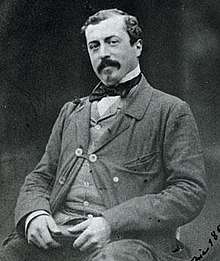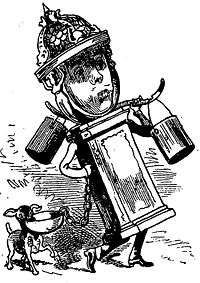Sir Richard Wallace, 1st Baronet


Sir Richard Wallace, 1st Baronet (21 June 1818 – 20 July 1890) was an English art collector.
Life
He was the illegitimate son of Richard Seymour-Conway, 4th Marquess of Hertford, by whose family he was educated in Paris and for whom he worked as private secretary. In 1870 he inherited his father's unentailed estates and extensive collection of European art.[1]. On 15 Feb. 1871 he was married to Julie Amélie Charlotte, the daughter of Bernard Castelnau, a French officer. Wallace expanded his father's collection himself; his widow donated the Wallace Collection to the nation in 1897. It is now located in what was his London home, Hertford House in Manchester Square.
His bequests to the people of Lisburn in Northern Ireland include the Wallace Park and The Wallace High School. His town house on Lisburn's Castle Street is now used as offices by the South Eastern Regional College. His country house at Sudbourne Hall, near Orford, Suffolk, (with 50 rooms, owned 1904-1916 by the millionaire parents of Kenneth Clark) was demolished in 1951.[2]
Despite his father's penurious reputation, Wallace achieved fame during the Siege of Paris for notable acts of charity.
At his own expense, Wallace organized two full scale ambulances[3] to operate during the siege; one to serve French wounded, and the second for the benefit of sick and destitute Britons." [4]
By the end of the siege, Wallace is estimated to have privately contributed as much as 2.5 million (1870) francs to the needy of Paris. This is perhaps equivalent to $6.5 million in 2010 money. As a result, Wallace was thought to be the most popular British citizen inhabiting Paris during the siege. The last balloon to leave Paris before its capitulation was named for him, as was a Paris boulevard. He received a Legion d'Honneur for his efforts.[5]
Wallace was created baronet in 1871 and was a Conservative and Unionist Member of Parliament for Lisburn from 1873 to 1885. In 1872 he donated 50 drinking fountains, known as Wallace fountains, to Paris and to Lisburn. Some can still be seen today. He was Honorary President of Ipswich Museum from 1874 until his death. In 1883 he won a Silver medal at the Smithfield Show as breeder of the best "Single Pig" in class LXXXVI; he lived at Wickham Market in Suffolk at the time.
Upon his death in 1890, he was interred in Le Père Lachaise Cemetery in Paris.
References
- ↑ Jones, Jonathan (19 June 2018). "Sir Richard Wallace: The Collector review – glories from the age of global plunder". The Guardian. Retrieved 22 July 2018.
- ↑ The house and its 11,000-acre estate are described in Kenneth Clark, a Biography by Meryle Secrest (Holt, Rinehart and Winston, 1984) chap. 3,
- ↑ The term ambulance in 1870 meant both a field hospital as well as the means to pick up the wounded. The latter has become the exclusive meaning of 'ambulance'.
- ↑ Horne, Alastair (1965) The Fall of Paris: The Siege and the Commune 1870-71, pgs 167-168. Penguin Books, London. ISBN 978-0-14-103063-0
- ↑ Ibid.
Further reading
- Mallett, Donald (1979). The Greatest Collector: Lord Hertford and the Founding of the Wallace Collection. London: Macmillan. ISBN 978-0-333-24467-8.
External links
| Wikimedia Commons has media related to Sir Richard Wallace. |


- The Life and Work of Sir Richard Wallace Bart. MP
- Website of the Wallace Collection
- The Wallace High School
- Lisburn City
- Lisburn City Council
| Parliament of the United Kingdom | ||
|---|---|---|
| Preceded by Edward Wingfield Verner |
Member of Parliament for Lisburn 1873 – 1885 |
constituency abolished |